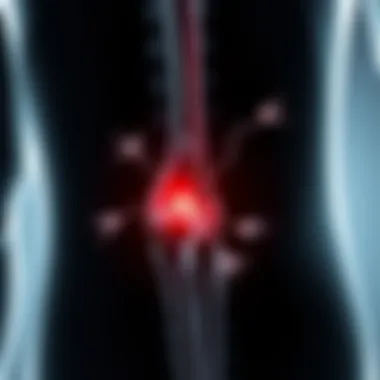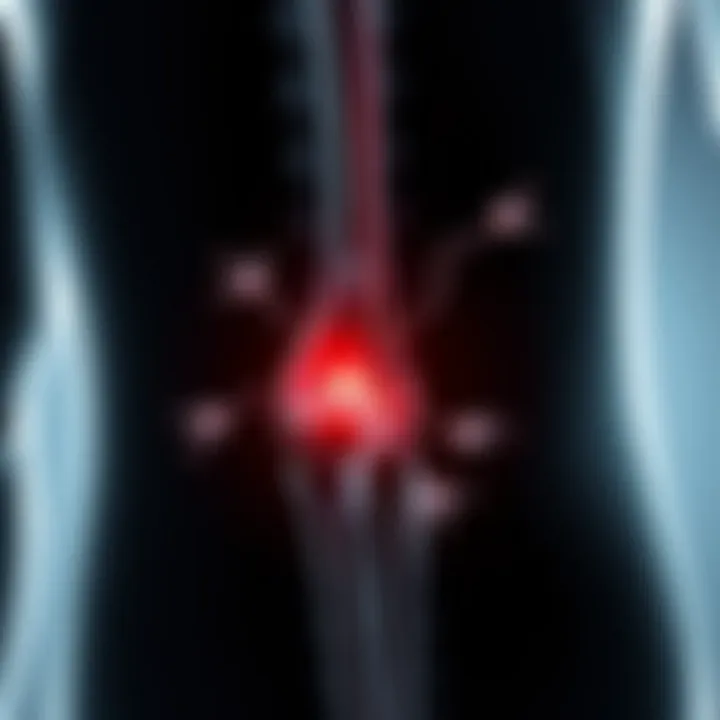The Role of Proteins in Arthritis Pain Management


Article Overview
Purpose of the Article
This article aims to delve into the complex interactions between specific proteins and arthritis pain. It seeks to uncover how certain proteins, particularly cytokines and chemokines, play pivotal roles in inflammation and joint health. The exploration extends beyond mere identification; it examines the mechanisms through which these proteins influence pain perception and disease progression. This understanding is vital for developing effective treatment strategies and improving the quality of life for those afflicted by arthritis.
Relevance to Multiple Disciplines
The implications of this subject span numerous areas, including
- Medicine: It offers insights for healthcare professionals aiming to better manage arthritis pain.
- Biochemistry: The intricate relationships between proteins and physiological responses are critical to researchers in this field.
- Nursing: Understanding protein roles can aid nurses in patient education and care planning.
- Pharmaceutical Sciences: Knowledge of protein functions directs drug development efforts.
By examining the roles of proteins in arthritis, the article highlights the interdisciplinary nature of pain management and treatment strategies, making the content suitable for a diverse audience ranging from researchers and healthcare providers to individuals seeking knowledge about arthritis.
Research Background
Historical Context
The study of proteins related to arthritis pain has evolved significantly over the years. Initially, the focus was primarily on the structural aspects of joints and the inflammatory responses, neglecting the biochemical interactions that contribute to pain.
As research progressed through the late 20th century, key breakthroughs occurred. Scientists began to identify specific proteins involved in the inflammatory process. For instance, the discovery of cytokines—such as tumor necrosis factor-alpha (TNF-α)—shifted the focus towards understanding these proteins' roles in joint diseases. This historical trajectory culminated in the development of targeted therapies that modulate these protein interactions to alleviate pain effectively.
Key Concepts and Definitions
To navigate this intricate subject, certain key concepts must be defined:
- Cytokines: These are signaling proteins that modulate immune responses and inflammation. They can exacerbate or alleviate arthritis pain.
- Chemokines: A subset of cytokines, chemokines specifically induce the migration of immune cells to sites of inflammation.
- Inflammation: A biological response to injury or infection, often resulting in pain, swelling, and redness in the joints.
- Joint Health: Refers to the overall condition of joints, including mobility and physical function. Poor joint health is often manifested as arthritis pain.
The nuanced understanding of these terms helps build a foundation for appreciating their roles in pain management, making the subsequent discussions throughout the article not only critical but also accessible to readers from various backgrounds.
Prelims
Arthritis is not just a single condition; it's an umbrella term that encompasses various joint disorders, each manifesting unique challenges and symptoms. Given the intricate nature of arthritis, understanding its origins and implications is crucial for effective treatment and management strategies. This section aims to lay out a roadmap for readers, highlighting how proteins play a substantial role in the experience of arthritis pain.
The relationship between proteins and arthritis is often overlooked, yet it is central to comprehending the biological mechanisms that govern inflammation and pain. Recognizing this connection is pivotal for researchers and practitioners alike, as it offers vital insights that could lead to innovative approaches in therapy. By delving into the finer details of how specific proteins function, we can unlock new avenues for enhancing patient care.
By engaging with the material in this article, readers can benefit by gaining a richer understanding of arthritis pain management. This knowledge is not only beneficial for healthcare providers aiming to employ evidence-based practices but also for patients seeking to understand their condition better. Understanding the biological underpinnings is akin to having a map in unfamiliar territory—without it, navigating the complexities of arthritis becomes daunting.
In summary, this introduction serves as a crucial foundation for exploring the nuanced roles that proteins play in arthritis pain—a subject that merits attention for its implications in both research and real-world applications.
"Understanding the biological mechanisms behind arthritis pain is the first step in improving the quality of life for those affected."
"Understanding the biological mechanisms behind arthritis pain is the first step in improving the quality of life for those affected."
Prepare to journey through this narrative that connects laboratory findings to therapeutic strategies, ensuring a well-rounded approach to tackling arthritis pain.
Understanding Arthritis Pain
Arthritis pain is not merely discomfort; it represents a complex interplay of biological processes that can significantly impact the quality of life for those affected. Understanding the multifaceted nature of this pain is crucial in appreciating how proteins play a pivotal role in its development and management. This aspect of arthritis treatment is getting increasing attention, particularly as the connection between inflammation and pain is being clarified.
Types of Arthritis and Their Symptoms
Arthritis is not just one condition but a term that encompasses over a hundred different types of joint disorders. Among these, some of the most common types include:
- Osteoarthritis (OA): This is often termed wear-and-tear arthritis. It's characterized by a gradual loss of cartilage, which leads to bone rubbing against bone. Patients usually experience stiffness, swelling, and a crunching sensation in the affected joints, particularly after prolonged use.
- Rheumatoid Arthritis (RA): This is an autoimmune condition where the immune system mistakenly attacks joint tissues. Symptoms can vary but typically include joint pain, swelling, and morning stiffness that lasts more than an hour.
- Psoriatic Arthritis: This is linked with psoriasis, a skin condition. Symptoms can range widely but often include joint pain, swelling, and skin lesions.


Understanding these different types is vital since the underpinnings of pain can differ significantly from one form of arthritis to another. Once a specific type is identified, the treatment can be more accurately tailored to address the unique biological markers and pain mechanisms involved.
The Pain Mechanism
The mechanisms behind arthritis pain are also intricate. At the heart of this complexity is the role of inflammation, where proteins significantly contribute to both signaling and response. Here are some key elements to consider:
- Inflammatory Cytokines: These are small proteins released by cells that affect the behavior of other cells. In arthritis, cytokines such as TNF-alpha and IL-6 become elevated and drive the inflammatory process, translating into pain signals that reach the brain.
- Nerve Sensitization: Chronic inflammation can lead to alterations in nerve sensitivity. This means that even a slight movement can trigger significant pain, as the sensors in the affected joint become overly reactive.
- Cartilage and Joint Structure: As the disease progresses, alterations in cartilage and joint structure may lead to increased friction and stress during movement, which can worsen pain.
"Pain is more than a symptom; it is both a physical and emotional experience that can alter daily living."
"Pain is more than a symptom; it is both a physical and emotional experience that can alter daily living."
Understanding the mechanisms of pain not only illuminates the biological processes at play but also emphasizes the potential for targeted treatment strategies. By focusing on specific proteins and their roles, researchers are unraveling pathways that might be interrupted to ease pain and inflammation. This intersection of biology and practical application is an exciting frontier in arthritis research that holds promise for better management strategies.
The Role of Proteins
When delving into the complex landscape of arthritis pain, the significance of proteins stands out prominently. Proteins are not only fundamental building blocks of the body but also play pivotal roles in signaling and regulation, influencing inflammatory responses and joint health profoundly. This article aims to unravel how specific proteins contribute to arthritis pain, shedding light on their multifaceted functions, implications for treatment, and possible pathways for future research.
The involvement of proteins in arthritis is multi-layered, with each type offering unique insights into disease mechanisms. For instance, the inflammatory proteins produced during disease exacerbation shed light on the body’s response mechanisms to joint stress and damage. These proteins serve various roles ranging from signaling to direct involvement in tissue degradation. Understanding these roles is essential for developing effective therapy approaches and managing patient care.
Cytokines in Inflammation
Cytokines have emerged as critical mediators in the inflammatory processes associated with arthritis. These small proteins act as messengers that facilitate communication between cells, orchestrating the immune response. In the case of arthritis, pro-inflammatory cytokines, such as tumor necrosis factor-alpha (TNF-alpha) and interleukin-1 (IL-1), are particularly notorious for their role in promoting inflammation and, consequently, pain.
Inflammation is a double-edged sword; it’s a natural response that has its purpose, but in conditions like arthritis, it can spiral out of control, leading to chronic pain and joint damage. Elevated levels of cytokines trigger a cascade of events that not only recruit immune cells to the site of inflammation but also sensitize nerve endings. This sensitization can amplify pain signals, leading to heightened discomfort for the patient. More specifically, the joint would suffer through swelling, warmth, and stiffness, all due in part to the cytokines at play.
"Cytokines can be seen as the alarm bells of the immune system, alerting it when there’s trouble in the joints."
"Cytokines can be seen as the alarm bells of the immune system, alerting it when there’s trouble in the joints."
Chemokines and Recruitment of Immune Cells
Chemokines, a subset of cytokines, play a vital role in the recruitment of immune cells to the inflamed tissues. They guide immune cells through the bloodstream to the exact sites where they're needed, acting almost like traffic signals. In conditions characterized by excessive inflammation, such as arthritis, chemokines not only help in bringing immune cells to the joint but also contribute to the persistence of inflammation.
The recruitment process can lead to a vicious cycle; as more immune cells enter the inflamed joint, they release additional pro-inflammatory signals, resulting in more pain and damage. This cycle highlights the importance of targeting chemokines in treatment strategies. By interrupting this signaling pathway, it's possible to reduce inflammation and pain, allowing for improved patient outcomes.
Matrix Metalloproteinases and Cartilage Degradation
Matrix metalloproteinases (MMPs) are enzymes that play a crucial role in the breakdown of extracellular matrix components, including cartilage. In arthritis, certain MMPs become overactive, contributing to cartilage degradation and loss of joint integrity. This is unfortunate because cartilage acts as a protective layer in joints; when it degrades, the bones can rub against each other, causing pain and stiffness.
The involvement of MMPs in arthritis is particularly concerning because the degradation of cartilage is often irreversible. Understanding which MMPs are upregulated during arthritic conditions can offer insights for therapeutic interventions. Researchers are exploring potential inhibitors of MMPs as a means of slowing disease progression, highlighting the ongoing battle in the field of arthritis research to curb the damage caused by these enzymes.
Through the lens of proteins, we begin to extract the complex interactions that dictate arthritis pain. The roles of cytokines, chemokines, and matrix metalloproteinases tell a compelling story, illustrating how these proteins are not merely bystanders in the process but pivotal players in the ongoing struggle against arthritic discomfort. The research into these proteins not only informs us about the condition but also opens new doors for treatment strategies that could alleviate the burden for countless individuals.
Specific Proteins Associated with Arthritis Pain
Understanding the proteins that play a role in arthritis pain is crucial for advancing both research and treatment options. These proteins are not merely passive players; they actively shape inflammation and joint health through various pathways. By pinpointing specific proteins, researchers can devise targeted therapies and even personalized medicine approaches. This section delves into pivotal proteins such as TNF-alpha, IL-1, IL-6, and TGF-β, clarifying their contributions to the mechanisms of arthritis pain and highlights their significance for patient care and treatment strategies.
TNF-alpha: A Key Player
Tumor Necrosis Factor-alpha, commonly known as TNF-alpha, is a central figure in the inflammatory response associated with arthritis. This cytokine is produced by various cells, particularly immune cells, as a response to pathogens or tissue injury. The presence of TNF-alpha can amplify the inflammatory processes, leading to joint swelling and pain.
Research shows that elevated levels of TNF-alpha correlate with increased severity of arthritis symptoms. When it binds to its receptors, it triggers a cascade of inflammatory reactions. This process not only exacerbates pain but also contributes to tissue damage over time.
=> Some therapies, called biologics, specifically target TNF-alpha, offering relief to many patients by dampening this inflammatory response. By blocking TNF-alpha, these treatments can significantly improve joint function and reduce pain.


Interleukin-1 (IL-1) and Its Contribution
Interleukin-1, particularly IL-1 beta, is another pro-inflammatory cytokine that plays a substantial role in arthritis pain. Produced mainly by activated macrophages, it is known to enhance the inflammatory milieu in the joints. IL-1 is not a lone wolf in this scenario; it often acts in concert with TNF-alpha, leading to an intensified inflammatory reaction.
The significance of IL-1 lies in its dual roles: it promotes inflammation by inducing other inflammatory cytokines and contributes to the degradation of cartilage. Its binding to specific receptors initiates signaling pathways that not only increase inflammation but also stimulate the production of matrix metalloproteinases, which further degrade cartilage.
In treatment contexts, targeting IL-1 can offer another avenue to alleviate pain and inflammation, although it has its challenges due to the complexity of its interactions in the immune system.
Interleukin-6 (IL-6) and Its Impact
IL-6 is a multifaceted cytokine involved in inflammation and metabolism, among other functions. In arthritis patients, elevated levels of IL-6 have been associated with disease activity and correlates with pain intensity.
What’s noteworthy is that IL-6 is produced not just in response to joint inflammation but also influences systemic effects, meaning that it can affect the entire body, leading to fatigue and malaise that often accompany arthritis flare-ups.
Therapeutically, understanding IL-6 opens doors to treatment strategies, such as monoclonal antibodies that inhibit IL-6 signaling pathways. These approaches aim to mitigate the systemic inflammation that worsens joint symptoms, illustrating the intricate connections between localized joint pathology and overall health.
Role of Transforming Growth Factor-beta (TGF-β)
Transforming Growth Factor-beta, or TGF-β, plays a more nuanced role in arthritis. Unlike the pro-inflammatory cytokines discussed, TGF-β typically serves as an anti-inflammatory cytokine. However, its role is context-dependent. In early disease stages, TGF-β may help regulate the immune response; in more chronic stages, it can promote fibrosis and joint stiffness.
The balance of TGF-β's effects is vital. While it can help mitigate inflammation, excessive TGF-β signaling can lead to adverse remodeling of connective tissue, which complicates the clinical picture of arthritic joints.
Current studies are focusing on how to manipulate TGF-β signaling in therapeutic contexts. Properly harnessing its properties could lead to groundbreaking insights into joint health and pain management strategies.
Overall, the intricate network of proteins involved in arthritis pain requires ongoing investigation. By understanding how these specific proteins interact and influence each other, researchers and clinicians can better devise therapies that target core issues in arthritis dysfunction.
Current Research Trends
The field of arthritis research is evolving rapidly. Focus on how proteins play a role in disease mechanisms is paramount. New insights into the interplay between these proteins and arthritis pain pave the way for innovative treatment strategies. As the understanding of protein interactions develops, it shapes how healthcare professionals approach patient care. This section delves into the prominent trends emerging currently, investigating both the latest therapeutic targets and the importance of biomarkers related to arthritis progression.
Novel Therapeutic Targets
Recent studies highlight several novel therapeutic targets that focus on proteins integral to the pathways of arthritis pain. These targets might lead to more effective treatments. For example, some researchers are exploring the inhibition of specific cytokines or receptors involved in inflammation. By doing this, they aim to reduce the pain and disability faced by millions suffering from arthritis.
Key proteins like TNF-alpha, which directly correlate with inflammation levels, are under scrutiny. Medications such as TNF inhibitors have shown effectiveness; however, finding additional protein targets can further optimize treatment options.
- Potential therapeutic targets include:
- IL-17: Plays a role in promoting inflammatory responses.
- IL-6: Linked with systemic inflammation and pain amplification.
- Chemokines: Responsible for the recruitment of immune cells to the site of inflammation.
By narrowing down to specific proteins for therapeutic approaches, researchers aim not just to relieve symptoms but to intervene early in the disease process. This could lead to breakthroughs that minimize joint damage over time.
Biomarkers for Disease Progression
Another avenue of exploration involves the identification of biomarkers for disease progression. These markers may provide critical insights into how arthritis evolves, helping doctors personalize treatment plans more effectively.
Biomarkers can serve various purposes:
- Predict disease flares based on protein levels—providing timely intervention opportunities.
- Assess treatment efficacy through monitoring changes in protein concentrations over time.
- Evaluate disease severity by comparing patient samples to established normal ranges.
For instance, the level of C-reactive protein (CRP) is often assessed in clinical settings. Elevated levels indicate increased inflammation, guiding physicians on the treatment necessity. Additionally, ongoing research aims at identifying even more specific biomarkers that could offer deeper insights into patient outcomes and enhance overall management strategies.
"By focusing on the nuances of proteins in arthritis, researchers are not just treating symptoms—they're aiming for a comprehensive understanding of the underlying mechanisms."
"By focusing on the nuances of proteins in arthritis, researchers are not just treating symptoms—they're aiming for a comprehensive understanding of the underlying mechanisms."


Treatment Approaches Influenced by Protein Understanding
Understanding the role of proteins in arthritis has significant implications for treatment strategies. The intricate relationship between proteins such as cytokines, chemokines, and matrix metalloproteinases and arthritis pain informs various therapeutic approaches. By recognizing the molecular dynamics at play, healthcare providers can tailor treatments to better target the underlying causes of arthritis pain rather than just the symptoms. This shift in perspective allows for more effective management of the condition, potentially leading to improved patient outcomes.
The following sections will delve into specific treatment modalities influenced by this protein understanding, particularly focusing on biologics and NSAIDs.
Biologics and Targeted Therapies
Biologics represent a cutting-edge approach within the landscape of arthritis treatments. These are products made from living organisms or contain components of living organisms. They work by specifically targeting proteins involved in the inflammatory process. For example, TNF-alpha antagonists like Enbrel and Humira are designed to inhibit the action of tumor necrosis factor-alpha, a protein that plays a pivotal role in systemic inflammation commonly associated with rheumatoid arthritis.
- Mechanism of Action: Biologics function by blocking the signals of specific cytokines, thus interrupting the inflammatory cascade that causes joint pain and damage. By doing this, they can lead to a robust reduction in symptoms and disease progression.
- Considerations: While biologics can offer significant benefits, their use may not be suitable for everyone. Factors such as prior infections, underlying health conditions, and even the medication’s cost are crucial in deciding whether they are the right fit for a patient.
The targeted nature of biologics allows for therapy to be customized based on an individual’s specific condition. This manifestation of personalized medicine reflects an evolving understanding of the molecular underpinnings of arthritis pain.
Role of Non-Steroidal Anti-Inflammatory Drugs (NSAIDs)
Non-Steroidal Anti-Inflammatory Drugs, commonly referred to as NSAIDs, are often the first line of defense in managing arthritis pain. Medications such as Ibuprofen and Naproxen work by inhibiting cyclooxygenase (COX) enzymes, essential for the production of prostaglandins that promote inflammation. In terms of protein involvement:
- Inflammatory Response Modulation: By dampening the production of these inflammatory proteins, NSAIDs can effectively alleviate pain and reduce swelling associated with arthritis.
- Long-term Use: However, long-term use of NSAIDs can have potential side effects, including gastrointestinal issues and cardiovascular risks. As a result, understanding when and how to use these drugs effectively is critical.
In summary, the treatment approaches influenced by our understanding of proteins and their connection to arthritis pain showcase a shift towards precision in medicine. With ongoing research in protein role and expression in inflammatory processes, the hope is to refine and advance therapeutic strategies for better management of arthritis.
Future Directions in Arthritis Research
As research continues to evolve, the landscape of arthritis treatment is shifting considerably. The focus on proteins and their roles in inflammation and pain management is opening new avenues for understanding and mitigating arthritis symptoms. Thus, exploring future directions in arthritis research is essential not just for advancing science, but also for improving patient outcomes. The complexities surrounding protein interactions and joint health highlight a need for continuous inquiry, which could lead to breakthroughs in therapeutic options.
Emerging Proteins of Interest
Recent studies have begun shining a light on various proteins that were previously underappreciated or overlooked in the context of arthritis. Consider the following proteins:
- S100 proteins: These proteins are known to be expressed in various types of arthritis. They play a crucial role in calcium signaling and inflammation. Emerging evidence suggests that they might be useful as both biomarkers and therapeutic targets.
- Osteopontin: This protein has been linked to the progression of joint degeneration. It is involved in many inflammatory processes and could provide insights into new treatment avenues.
- Fibroblast Growth Factors (FGFs): They are crucial in tissue repair and inflammation. Their role in joint health is becoming increasingly clear, signaling a shift in focus toward regenerative therapies.
Researchers are now investigating how these proteins interact with existing pathways in arthritis. Delving deeper into their functions could potentially unlock new strategies for pain reduction and slow disease progression.
Integration with Personalized Medicine
Personalized medicine seeks to tailor treatments based on individual genetic, environmental, and lifestyle factors. The integration of protein research into personalized medicine has the potential to revolutionize arthritis care. By understanding the specific proteins involved in an individual’s disease state, healthcare providers can predict which therapies may be most effective.
- Stratification of patients: This means categorizing patients based on their protein profiles. For example, elevated levels of certain cytokines could indicate a more aggressive form of arthritis, helping clinicians to customize interventions.
- Targeted therapies: With more knowledge about specific proteins, treatments can be designed to target these elements directly. For instance, biologics that inhibit particular cytokines can be matched to patients who exhibit high levels of those cytokines.
- Monitoring biomarkers: Personalized approaches could also include the use of biomarkers derived from protein studies as indicators of treatment efficacy, allowing for real-time adjustments in therapy.
Epilogue
In summing up the multifaceted relationship between proteins and arthritis pain, it’s clear that our understanding of these biological compounds is pivotal for both researchers and patients alike. As highlighted throughout the article, diseases like arthritis hinge greatly on the interplay of proteins such as cytokines and chemokines, which are at the heart of inflammation and pain mechanisms. The deeper we dive into the molecular details, the clearer the pathways emerge, showing us how these proteins can not only exacerbate pain but also provide potential targets for therapies.
Summarizing the Protein-Related Insights
To distill the insights related to proteins, several key points surface:
- Cytokines like TNF-alpha and IL-6 are not just markers of inflammation; they actively drive the pain associated with arthritis, demonstrating the necessity for targeted treatments that counteract their effects.
- Matrix metalloproteinases contribute significantly to joint degradation, indicating a need for interventions that can inhibit their activity.
- The evolving landscape of research continues to uncover new biomarkers and therapeutic targets, expanding our arsenal against arthritis pain.
Understanding these proteins reveals why they matter and how they can open doors to novel therapeutic avenues. For instance, the ongoing research into biologics reflects an integrative approach to treatment, emphasizing the importance of protein interactions.
Implications for Patient Care
For the individual navigating arthritis, the implications of these findings are profound. Recognizing how inflammation and pain connect at the protein level can help in crafting personalized treatment plans that align closely with a patient's unique biological makeup.
- Patient education about the roles of specific proteins can foster better compliance with treatment regimens, as individuals become more aware of what drives their symptoms.
- There’s a clear call for healthcare providers to remain updated on protein-related advances, which could directly influence treatment choices and outcomes.
"Understanding how proteins influence pain opens up new pathways for managing arthritis more effectively."
"Understanding how proteins influence pain opens up new pathways for managing arthritis more effectively."
By integrating advancements in protein research with practical patient care strategies, clinicians can refine the approach to arthritis management. This might not only enhance patient outcomes but also contribute to a larger shift towards more effective and personalized treatment options in the field of arthritic pain relief. As we look towards the future, the ongoing exploration of proteins stands to reshape our understanding and treatment of arthritis.



